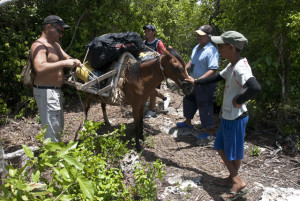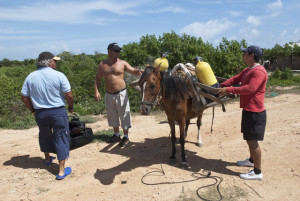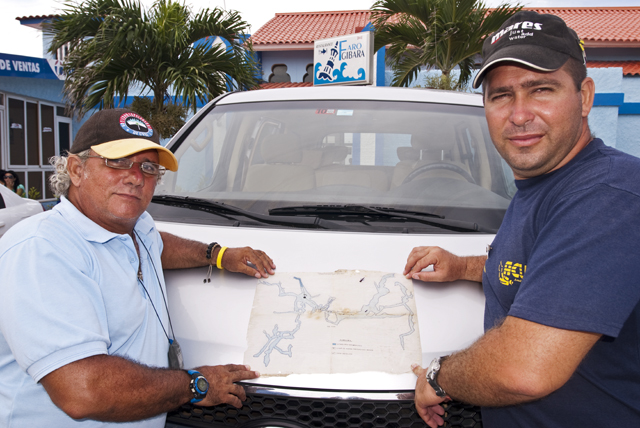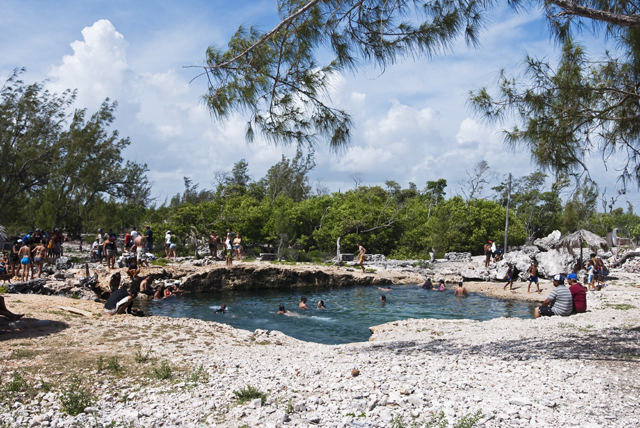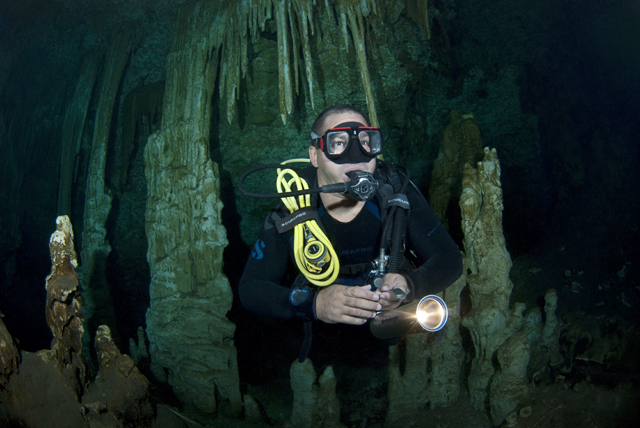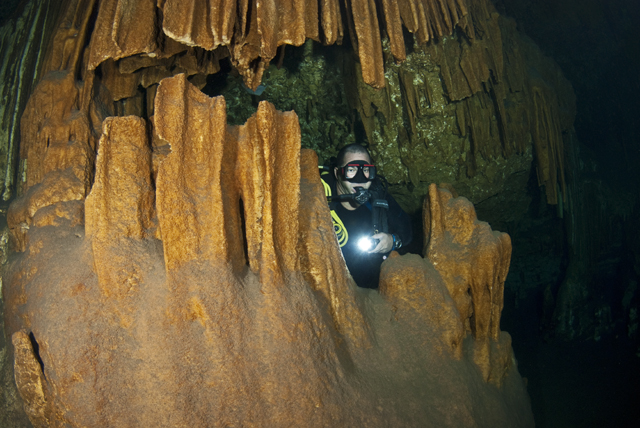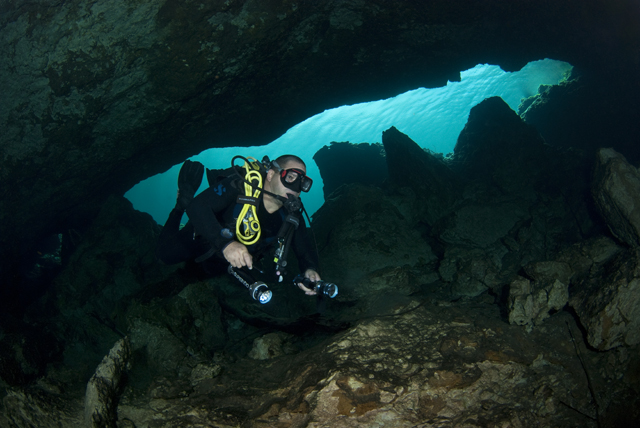News
Rumble in the Jungle: Cave Diving in Cuba
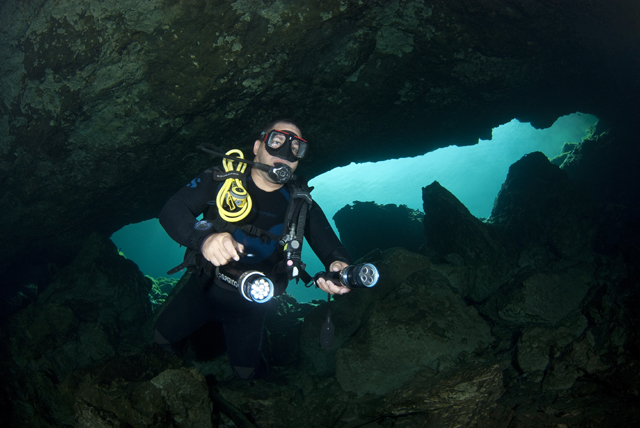
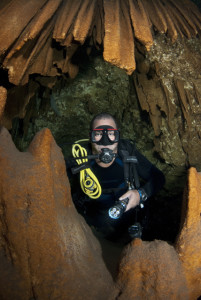 I was busy humming the Indiana Jones theme tune as we made our way through the jungle. This was by no means a ‘normal’ diving day and had turned out to be a real life adventure complete with the full entourage of creepy crawlies. Our tropical surroundings were alive with squawking Birds, Crabs, Geckos, Snakes (not poisonous I might add) and other exotic bugs. I was definitely experiencing raw Cuba at its very best. Jorge Millet Corchete, the Manager of Eagle Ray Dive Centre, had told me about two, virtually un-dived, underwater cave systems located 70km from the popular beach resort at Guardalavaca. After buttering me up with the exciting bits he then hit me with the bad news: the first cave system, known as Ring Hole, was a 1km walk through dense bush in the swelteringly hot sunshine. Worst still, the second system called Blue Tank, which in Jorge’s mind was much better for photographs, clocked in at more than 3km’s from the drop off point. Why are the best sites always the furthest away and hardest to get too? The saying ‘no pain, no gain’ came to mind as I mentally prepared myself for the cardiac inducing hike.
I was busy humming the Indiana Jones theme tune as we made our way through the jungle. This was by no means a ‘normal’ diving day and had turned out to be a real life adventure complete with the full entourage of creepy crawlies. Our tropical surroundings were alive with squawking Birds, Crabs, Geckos, Snakes (not poisonous I might add) and other exotic bugs. I was definitely experiencing raw Cuba at its very best. Jorge Millet Corchete, the Manager of Eagle Ray Dive Centre, had told me about two, virtually un-dived, underwater cave systems located 70km from the popular beach resort at Guardalavaca. After buttering me up with the exciting bits he then hit me with the bad news: the first cave system, known as Ring Hole, was a 1km walk through dense bush in the swelteringly hot sunshine. Worst still, the second system called Blue Tank, which in Jorge’s mind was much better for photographs, clocked in at more than 3km’s from the drop off point. Why are the best sites always the furthest away and hardest to get too? The saying ‘no pain, no gain’ came to mind as I mentally prepared myself for the cardiac inducing hike.
Jorge said at the beginning they used to cover the journey in rented 4 x 4’s but the hire companies got wise when the Jeeps kept coming back completely trashed. Jorge seemed to think that the gentle ‘stroll’ added an extra ‘feel good factor’ to the whole experience. I didn’t have quite as many positive vibes as Jorge but after some gentle persuasion (one or two Mojitos – I’m cheap!) I agreed to take part in the event.
We stopped off at the town of Gibara along the way to pick up some 4-legged help. Jorge’s friend Floro owned the Mule that we were using to carry all our diving equipment. I asked Floro what the Mule was called but he told me that it changed daily depending on how he felt. I decided to call the Mule ‘Pepe’ as it seemed quite appropriate for this neck of the woods.
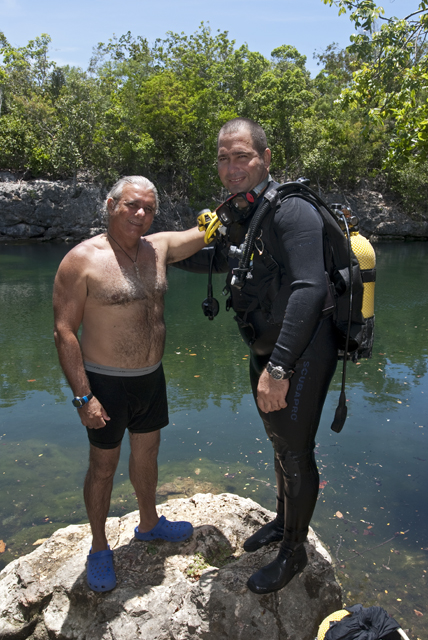 We had also picked up Jose Corella, the local cave diving Guru. Jose, a Geologist by trade, had been diving inside the caves since the late 80’s and had clocked up more than 300 deep penetration dives. He became fascinated by above water caves from an early age. Military friends introduced him to the Blue Tank and the rest was now history. Jose showed me the detailed maps he had made of the cave systems. He had chartered more than 3,000 metres inside the Blue Tank and so far had not reached an ending in any of the 3 independent entrances. Jose had a theory that Ring Hole may well join up to the Blue Tank, it’s just that no one had tried to find out. As well as making maps Jose had laid most of the 3,000 metres of line complete with directional arrows for other divers to follow. As far as Jose knew Czech divers were the first to explore the caves back in 1982. Eagle Ray Dive Centre began offering guided dives to UK tourists in 2004. Jorge said that divers have to be minimum PADI Advanced qualified to explore in the light zone (around the entrances) and he prefers them to do several standard sea dives before venturing inside the caves. This gave Jorge a chance to check the divers out and see how comfortable they were in the water. Jorge said he would only take certified cave divers deeper inside. So far there have been no serious incidents at Ring Hole or the Blue Tank.
We had also picked up Jose Corella, the local cave diving Guru. Jose, a Geologist by trade, had been diving inside the caves since the late 80’s and had clocked up more than 300 deep penetration dives. He became fascinated by above water caves from an early age. Military friends introduced him to the Blue Tank and the rest was now history. Jose showed me the detailed maps he had made of the cave systems. He had chartered more than 3,000 metres inside the Blue Tank and so far had not reached an ending in any of the 3 independent entrances. Jose had a theory that Ring Hole may well join up to the Blue Tank, it’s just that no one had tried to find out. As well as making maps Jose had laid most of the 3,000 metres of line complete with directional arrows for other divers to follow. As far as Jose knew Czech divers were the first to explore the caves back in 1982. Eagle Ray Dive Centre began offering guided dives to UK tourists in 2004. Jorge said that divers have to be minimum PADI Advanced qualified to explore in the light zone (around the entrances) and he prefers them to do several standard sea dives before venturing inside the caves. This gave Jorge a chance to check the divers out and see how comfortable they were in the water. Jorge said he would only take certified cave divers deeper inside. So far there have been no serious incidents at Ring Hole or the Blue Tank.
We drove to a clearing and waited for Pepe the Mule to arrive. Jorge, an ex-Cuban Navy SEAL, had stripped down to his waist and was raring to go. I followed Jorge’s lead by ripping off my t-shirt and slapping on a good helping of factor 30. I had put the Strobes and other camera/dive gear into my rucksack which now weighed in at around 15kg’s. I thought it would be best to carry my housing and camera by hand. In no time at all Pepe had arrived, was packed, had a poo and began trotting down the jungle path. I followed along behind Jorge and Jose (dodging Pepe’s fall out). The track was mainly made up of broken uneven rocks making it very difficult to walk on. My flip-flops weren’t exactly the most appropriate footwear for this kind of terrain. I managed to stub my toes (and swore) a number of times. I asked Jose why they hadn’t made a proper pathway to the Blue Tank and he said that this would only encourage more locals to visit the spot and he preferred to keep them away. He told me there had been a 30 metre long underwater tunnel connecting the town’s popular swimming hole to the open sea. Authorities decided to block up the entrance, with a controlled explosion, after a number of people drowned trying to breath hold swim through the tunnel. Jose didn’t want the caves to suffer a similar fate. Jorge said ‘nearly everyone moans about the walk and they constantly ask ‘are we there yet?’ but when they see inside the caves they are much happier and forget about the return journey’. Jose talked non-stop for the whole 3km’s, which was enough to distract me from the ever growing number of Mosquito blotches appearing all over me (I counted about 30 in total).
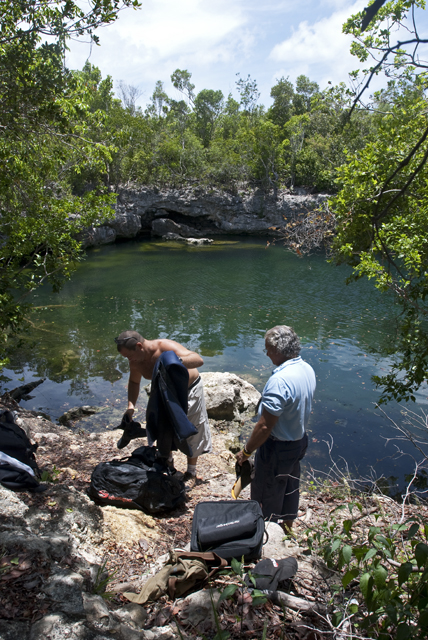 Jose said that the pond measured in at 30 x 15 metres. The seemingly ‘dead pool’ was surrounded by dense bushes and trees apart from one spot where there was a narrow pathway leading down to the water’s edge. Jorge saw a something break the mirror calm surface. A Turtle popped its head up and then quickly disappeared again. This is the first time he had ever seen a Turtle in the pond.
Jose said that the pond measured in at 30 x 15 metres. The seemingly ‘dead pool’ was surrounded by dense bushes and trees apart from one spot where there was a narrow pathway leading down to the water’s edge. Jorge saw a something break the mirror calm surface. A Turtle popped its head up and then quickly disappeared again. This is the first time he had ever seen a Turtle in the pond.
Jorge guided me to the first cave entrance which was big enough for at least six divers to enter side by side. The bottom of the pond was around 6-8 metres deep and covered in a thick luminous green layer of algae, branches and dead leaves. I stopped to take a picture of Jorge entering the cave and felt something feeding on my ankles. I looked down and saw hundreds of Prawns ‘cleaning’ any part of my skin they could find. The pond was far from dead. I had missed out on some really good Macro opportunities.
My equipment wasn’t adequate for a full-on penetration dive but I decided to take a risk and venture in more than 100m’s keeping a firm eye on the guideline and my air gauge needle. The inner chambers were massive with 2 metre long spiky Stalactites hanging from the roof and stubby Stalagmites growing up from the cave floor. When I’m taking photographs I sometimes use a finger touch on a rock just to steady myself. But as I touched the top of a small Stalagmite it broke off. It was only a small piece just a few cm’s long but I was absolutely mortified. It had been such a gentle touch. I had no idea that they were so fragile. I really did learn a valuable lesson and doubled my buoyancy efforts. A diver with bad buoyancy skills inside this cave would be equivalent to a Bull in a China shop – nothing would survive. Afterwards Jorge told me that the orange looking rock formations were much stronger than the white looking ones. I wish he had said something earlier!
The huge chambers (as a rough guide – the size of a Bungalow) were an impressive sight and the further I went in the scenery just got bigger and better. The chambers seem to alternate between all Stalagmites and then all Stalactites. Jorge said that the maximum depth he had ever reached inside the caves was around 18 metres with the average depth being 15 metres. Water temp hovered around 24 degrees. Jorge suddenly made an ‘ugh’ noise from his regulator and as I turned around I caught sight of an Eel about 500cm long swimming away from us. Jorge said there were also 2 species of indigenous blind fish living inside the caves.
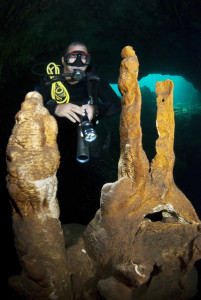
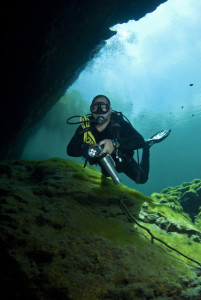 I made the mistake of putting my fins on the cave floor and found it was carpeted by a thick layer of silt. Within seconds my fin had totally sank into the soft quicksand. Even the slightest disturbance reduced the visibility dramatically. I was trying my best to ‘frog’ kick but my longish fins weren’t ideal for this type of environment.
I made the mistake of putting my fins on the cave floor and found it was carpeted by a thick layer of silt. Within seconds my fin had totally sank into the soft quicksand. Even the slightest disturbance reduced the visibility dramatically. I was trying my best to ‘frog’ kick but my longish fins weren’t ideal for this type of environment.
Jorge, or should I say Pepe, had brought along 4 powerful lamps, two of which were brand new, never been used, retailing at $800-00 a-piece. The blue anodised metal cases certainly looked impressive. I strategically placed the lamps on the floor of one of the huge Stalactite chambers and pointed them upwards. They lit up the scenery like a theatre stage. I wanted to try and get some shots of Jorge surrounded by the spectacular scenery. Having no natural light to work with made the whole set up quite challenging which I guess is very similar to a night dive where Macro subjects don’t usually pose a problem, but wide angle is much more difficult to light up. I managed to fire off a few pictures and then one of Jorge’s new LED lamps started flickering on and off. When I looked closer I could see water inside the glass and the level was rising fast. This was not a good advertisement for the lamp manufacturer. Later Jose told me that he used to use normal flashlights sealed inside knotted condoms when he first started and never had any problems! We had a good nose inside another of the cave entrances and I was surprised how different it looked. There were far more orange formations and they were a different size and shape.
Unfortunately there had been no time to properly plan and prepare for a full on exploration of the caves. My jungle dive had purely been a recon mission. I had completed a cavern course in the Brecon Beacons several years ago. We spent all of our time in a river or inside a mine shaft. Water temp was around 6 degrees. At the time I remember thinking what is the point in this? It was freezing cold and there was nothing to see, I know this was a training course, but it didn’t inspire me to progress any further. The Blue Tank was different. There were spectacular rock formations and even fish life to see and to be quite honest it was a nice feeling knowing I was only one of several hundred divers that had ever been inside the cave. As for the walk… well to be honest it wasn’t as bad as I imagined, and it did make me feel that I had ‘worked’ for my dive. We finished off our adventure with a few ice cold Bucanero beers and Lobster dinner at the El-Faro Restaurant. Not a bad ending to a full-on day! Jorge said the dinner is normally included in the package price and there’s no extra charge for Mosquito bites. Jorge has full cave diving equipment available at the dive shop but it’s only enough for the Instructors. Anyone seriously interested in going deep inside the caves should bring along their own gear.
Marine Life & Conservation Blogs
Creature Feature: Dusky Shark

 In this series, the Shark Trust will be sharing amazing facts about different species of sharks and what you can do to help protect them.
In this series, the Shark Trust will be sharing amazing facts about different species of sharks and what you can do to help protect them.
This month we’re taking a look at the Dusky Shark, a highly migratory species with a particularly slow growth rate and late age at maturity.
Dusky sharks are one of the largest species within the Carcharhinus genus, generally measuring 3 metres total length but able to reach up to 4.2 metres. They are grey to grey-brown on their dorsal side and their fins usually have dusky margins, with the darkest tips on the caudal fin.
Dusky Sharks can often be confused with other species of the Carcharhinus genus, particularly the Galapagos Shark (Carcharhinus galapagensis). They have very similar external morphology, so it can be easier to ID to species level by taking location into account as the two species occupy very different ecological niches – Galapagos Sharks prefer offshore seamounts and islets, whilst duskies prefer continental margins.
Hybridisation:
A 2019 study found that Dusky Sharks are hybridising with Galapagos Sharks on the Eastern Tropical Pacific (Pazmiño et al., 2019). Hybridisation is when an animal breeds with an individual of another species to produce offspring (a hybrid). Hybrids are often infertile, but this study found that the hybrids were able to produce second generation hybrids!
Long distance swimmers:
Dusky sharks are highly mobile species, undertaking long migrations to stay in warm waters throughout the winter. In the Northern Hemisphere, they head towards the poles in the summer and return southwards towards the equator in winter. The longest distance recorded was 2000 nautical miles!
Very slow to mature and reproduce:
The Dusky Shark are both targeted and caught as bycatch globally. We already know that elasmobranchs are inherently slow reproducers which means that they are heavily impacted by overfishing; it takes them so long to recover that they cannot keep up with the rate at which they are being fished. Dusky Sharks are particularly slow to reproduce – females are only ready to start breeding at roughly 20 years old, their gestation periods can last up to 22 months, and they only give birth every two to three years. This makes duskies one of the most vulnerable of all shark species.
The Dusky Shark is now listed on Appendix II of the Convention on the Conservation of Migratory Species (CMS), but further action is required to protect this important species.
Scientific Name: Carcharhinus obscurus
Family: Carcharhinidae
Maximum Size: 420cm (Total Length)
Diet: Bony fishes, cephalopods, can also eat crustaceans, and small sharks, skates and rays
Distribution: Patchy distribution in tropical and warm temperate seas; Atlantic, Indo-Pacific and Mediterranean.
Habitat: Ranges from inshore waters out to the edge of the continental shelf.
Conservation status: Endangered.
For more great shark information and conservation visit the Shark Trust Website
Images: Andy Murch
Diana A. Pazmiño, Lynne van Herderden, Colin A. Simpfendorfer, Claudia Junge, Stephen C. Donnellan, E. Mauricio Hoyos-Padilla, Clinton A.J. Duffy, Charlie Huveneers, Bronwyn M. Gillanders, Paul A. Butcher, Gregory E. Maes. (2019). Introgressive hybridisation between two widespread sharks in the east Pacific region, Molecular Phylogenetics and Evolution 136(119-127), https://doi.org/10.1016/j.ympev.2019.04.013.
Blogs
Join Pharaoh Dive Club for Red Sea Splash Family Summer Camp in August 2024
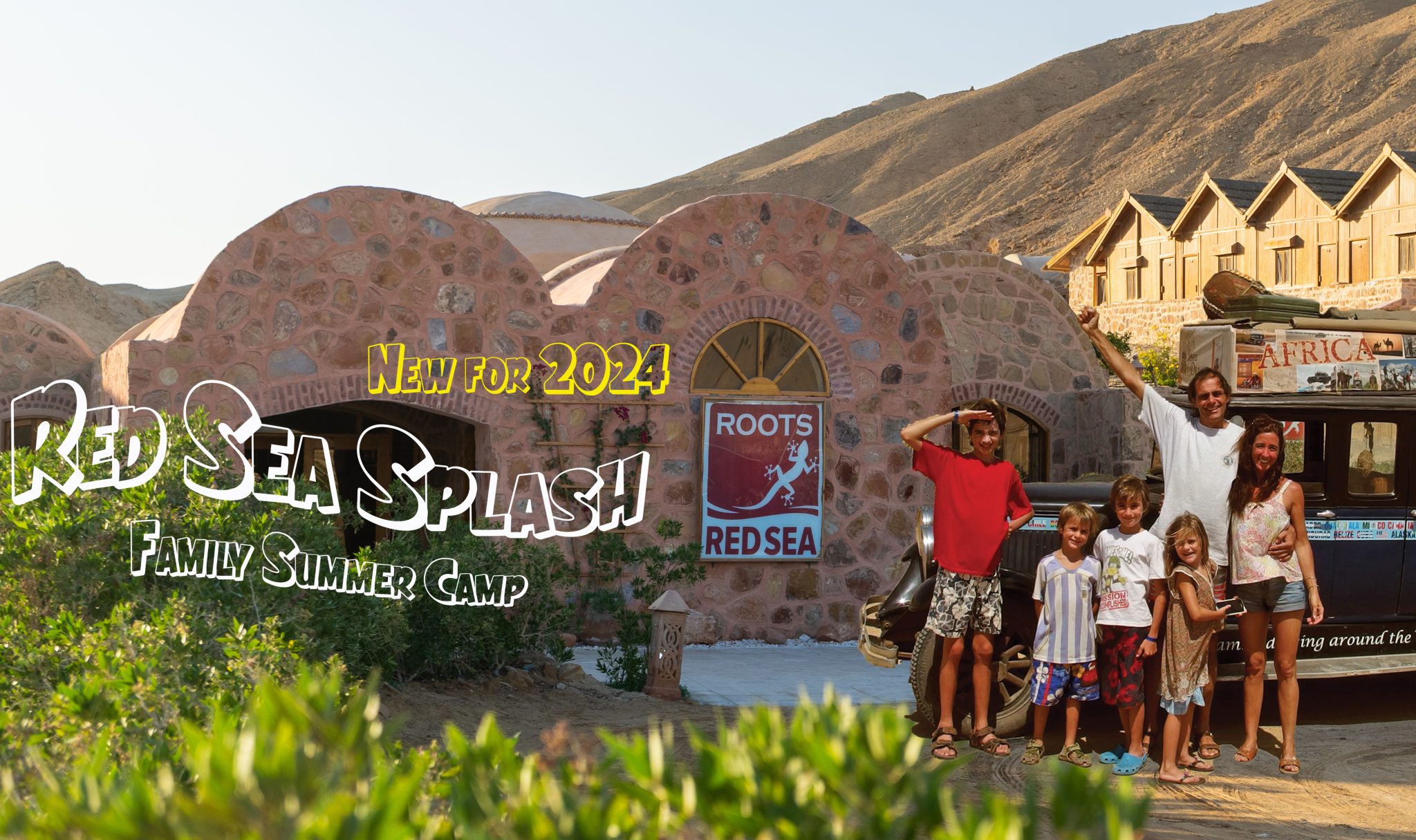
3rd AUGUST 2024 – 1 or 2 WEEK PROGRAMMES
Daily water programme with Snorkelling & Scuba Diving.
Beginners or qualified, something for all.
Leave the kids with the Splash Team for days of Excitement, Fun & Adventure!
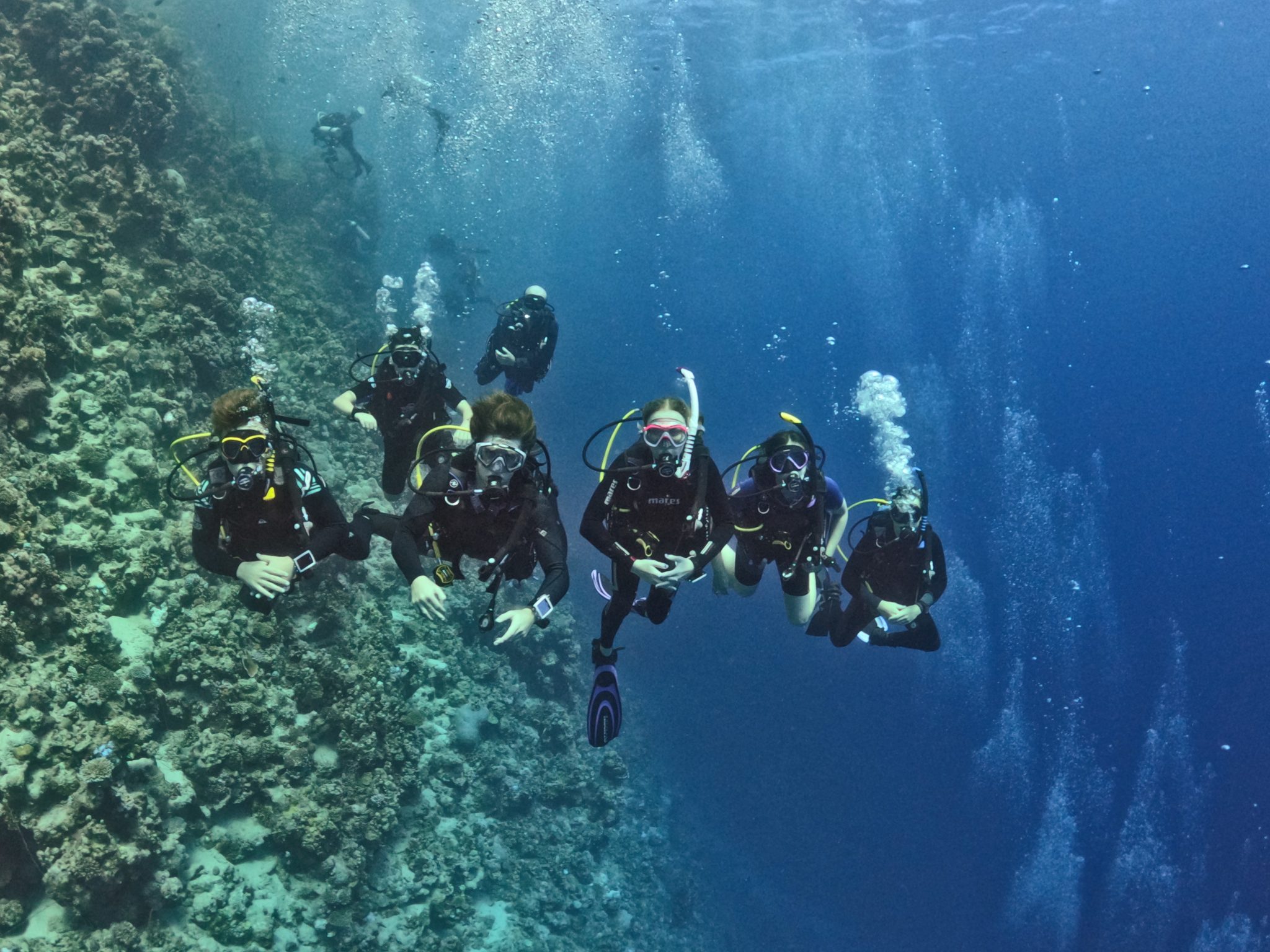
BOOK NOW: INFO@PHARAOHDIVECLUB.COM / TEL: +44 7598 329059 or +20 100 6822000
There are various options for accommodation with options for 2, 3, 4 or 5 guests.
Eco Huts provide accommodation for families of up to 4. The best option to enhance the adventure and closest to camping with basic facilities. For August we will provide central air cooling for all the Eco Huts.
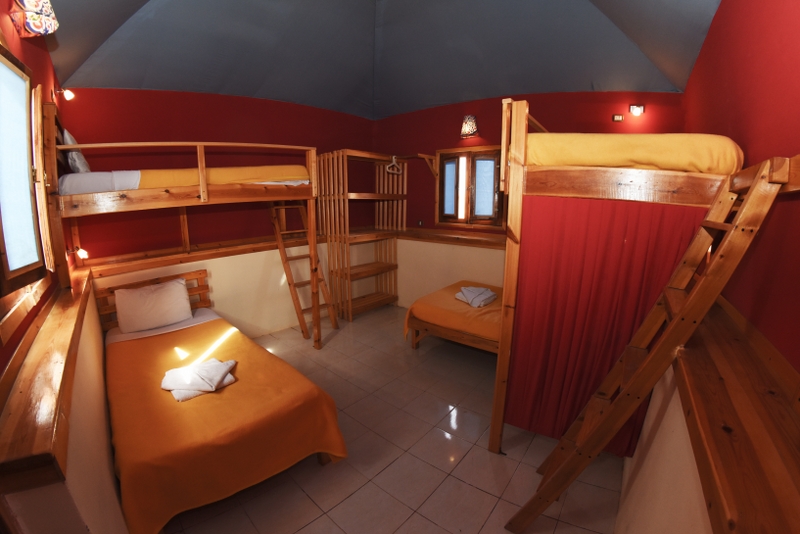
Deluxe Chalets are only suitable for 2 guests. Fully air conditioned rooms with private bathroom and other facilities.
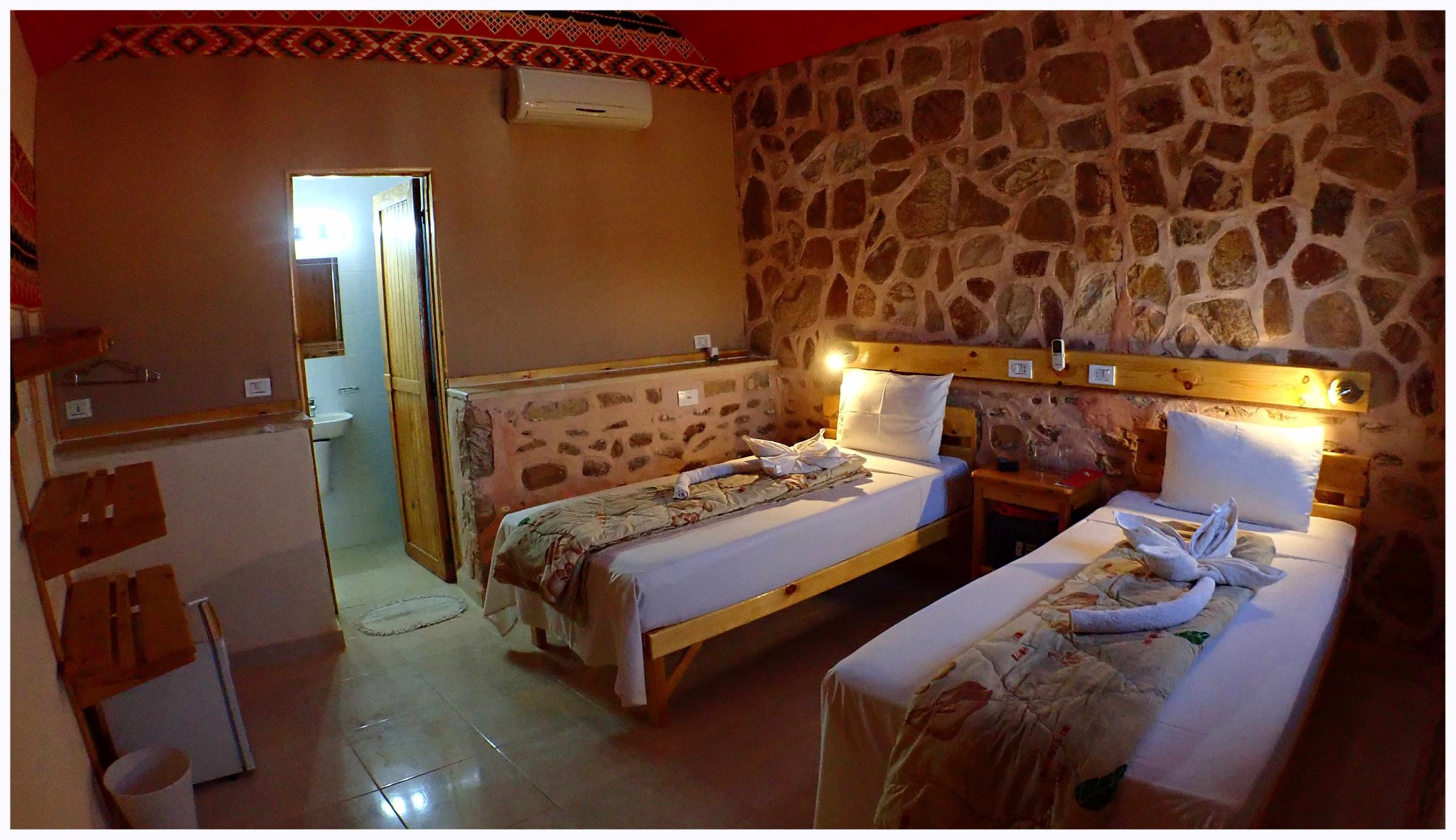
Boutique Rooms are available for families of up to 5.
Individual bespoke rooms fully air conditioned with private bathroom and other facilities.
Eco Huts: £675 per adult / £425 per child / Under 8 FREE of charge
Deluxe Chalet: £830 per adult / £505 per child / Under 8 FREE of charge
Boutique Room: £925 per adult / £550 per child / Under 8 FREE of charge
BOOK NOW: INFO@PHARAOHDIVECLUB.COM / TEL: +44 7598 329059 or +20 100 6822000
This is a truly unique opportunity to have a Family Desert Adventure totally away from it all! You will be based at the remote Roots Red Sea on the coast of the Egyptian Eastern Desert, 140km south of Hurghada city.
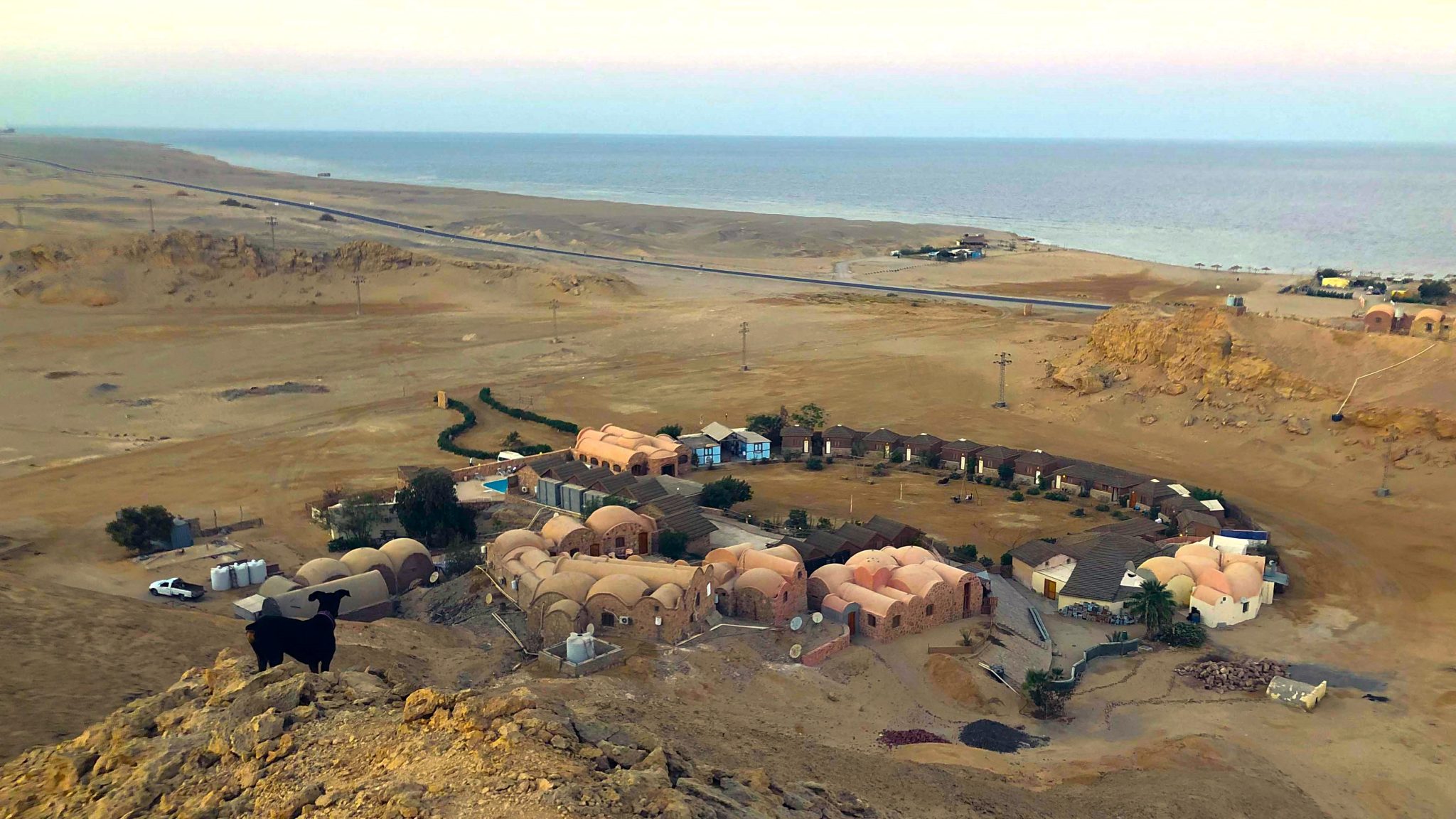
Red Sea Splash main focus is Snorkelling & Scuba Diving but that’s not all, we provide a rounded week of activities in support.
Pool& Field Games – Arts & Crafts
Marine Biology Workshops
Cultural Activities – Orienteering Adventures
Roots Red Sea have established strong links with the local communities of Hamerwain & El Quseir affording our guests to have a true taste of the local culture, SPLASH CAMP embraces this opportunity and bring in the local children to join in the fun with our adventure seekers.
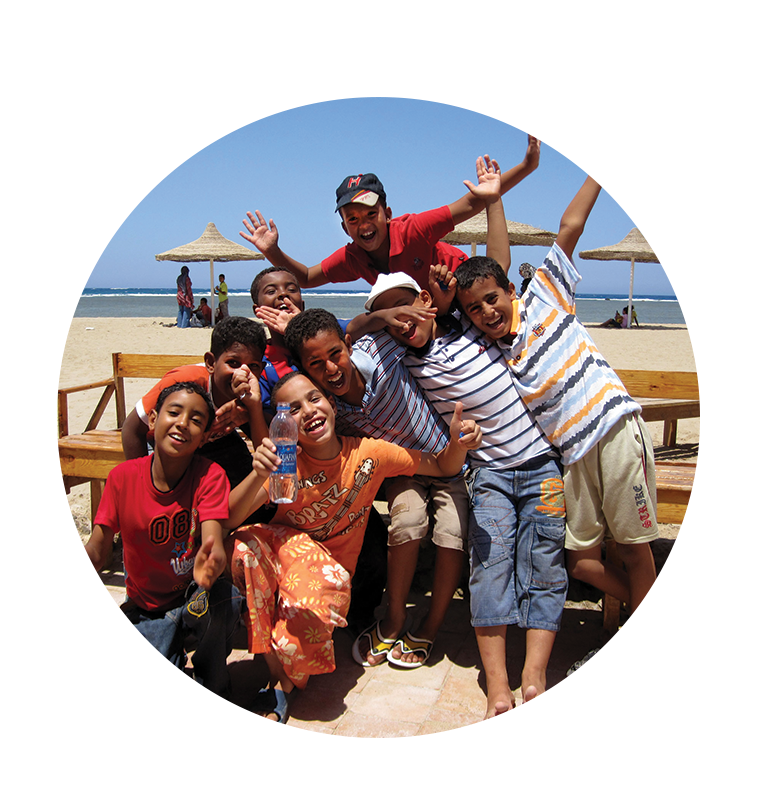
During the day, families are welcome to take part in all activities together or the kids can be left with the SPLASH CAMP team while the parents enjoy the facilities or go diving themselves!
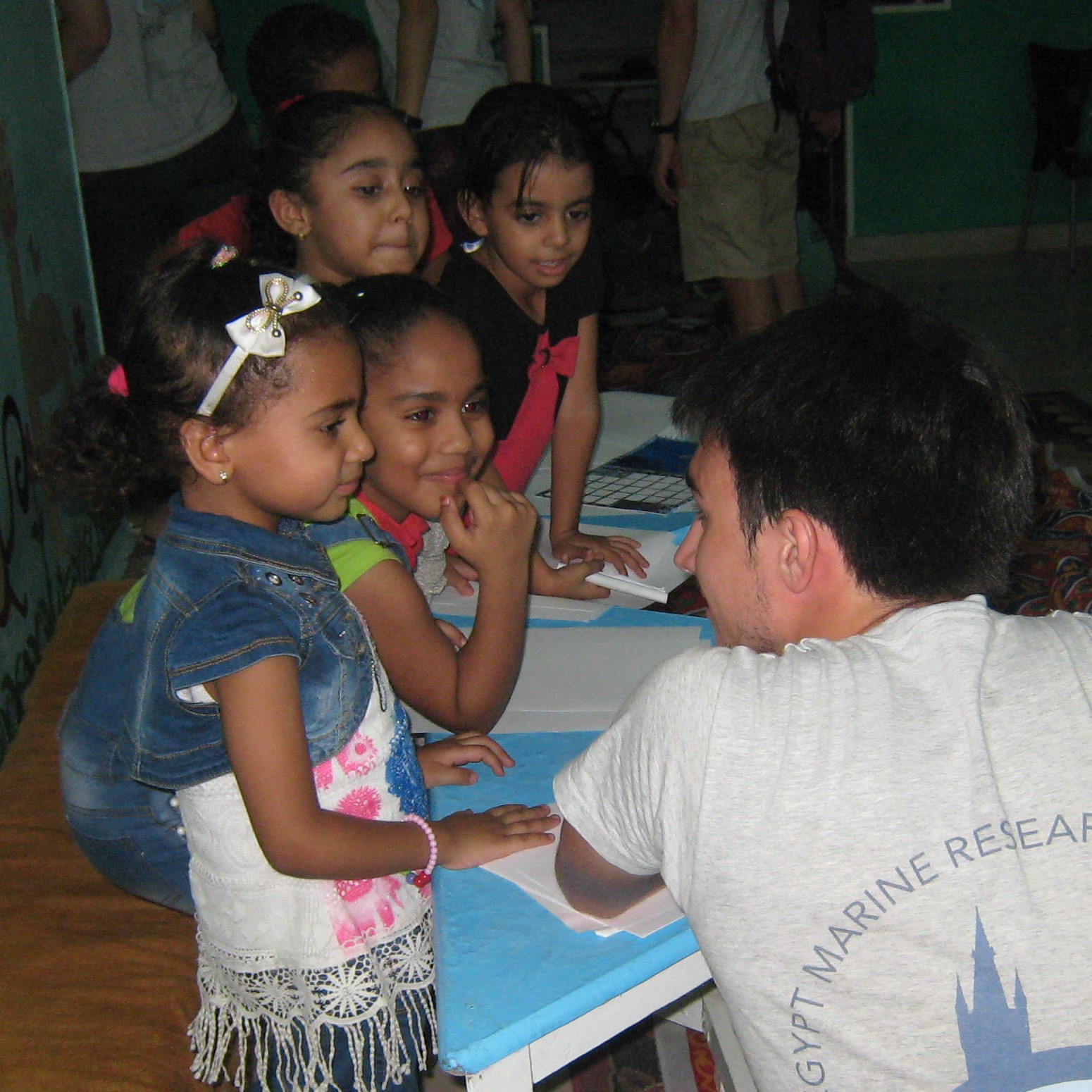
At the end of the day, its family time while the SPLASH CAMP team take a break. For those with the energy, there are family evening activities planned a few evenings.
Open Air Movie Night – Desert Star Gazing Walk & Talk
El Quseir Evening City Tour
The second week is very special, we head off on the Big Blue for a liveaboard safari around Fury Shoals.
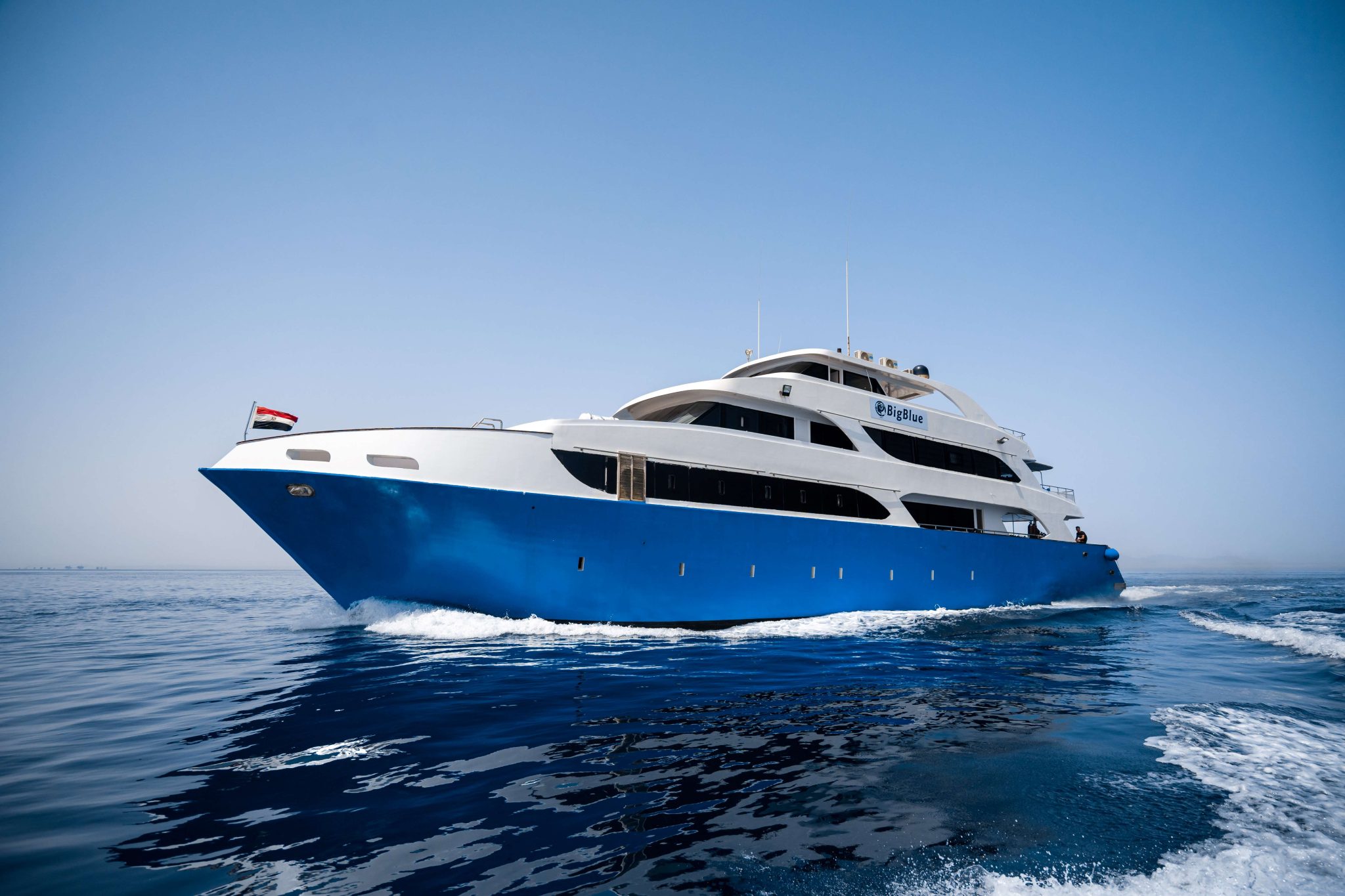
BOOK NOW: INFO@PHARAOHDIVECLUB.COM / TEL: +44 7598 329059 or +20 100 6822000
U-8 Splash Club
Sadly we can’t offer Scuba Diving to the Splash Club but we can have lots of fun Snorkelling & Free Diving!
Splash Club includes:
Certified Snorkel Course – Marine ID Games – Intro to Free Diving
Arts & Craft Sessions – Adventure trails – Cultural Playtime – Pool Games
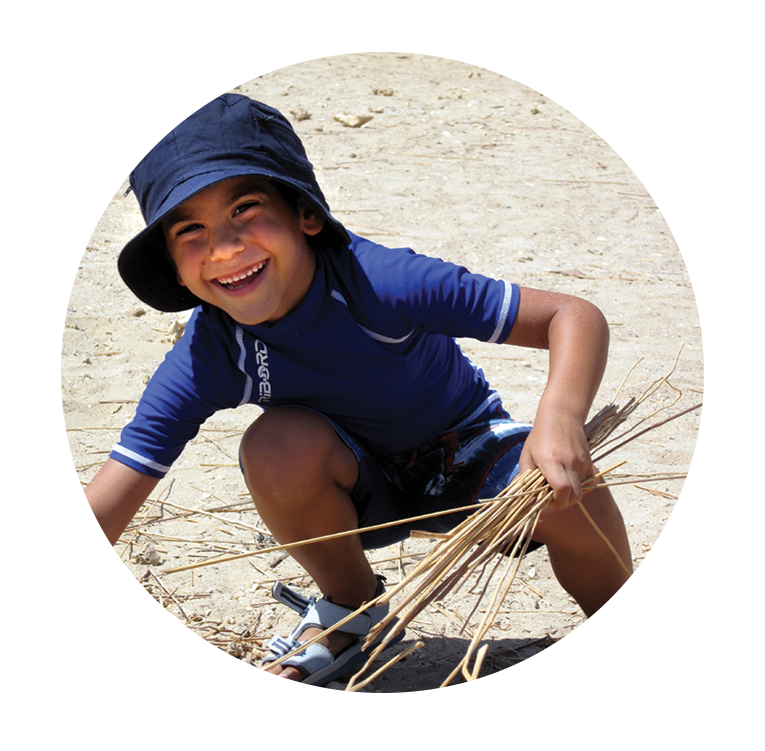
U-12 Explorer Club
In addition to an exciting snorkelling and Free Diving Programme in the Splash Club we can take you under the water on SCUBA to a whole new world of fun and wonder. If you are under 10 your first breath under water will be as a Bubblemaker and continue with daily Seal Team Missions. From 10 we will complete a Discover Scuba Diving experience in the amazing Red Sea. Alternatively we offer a full junior certification programme to become an international qualified Scuba Diver.
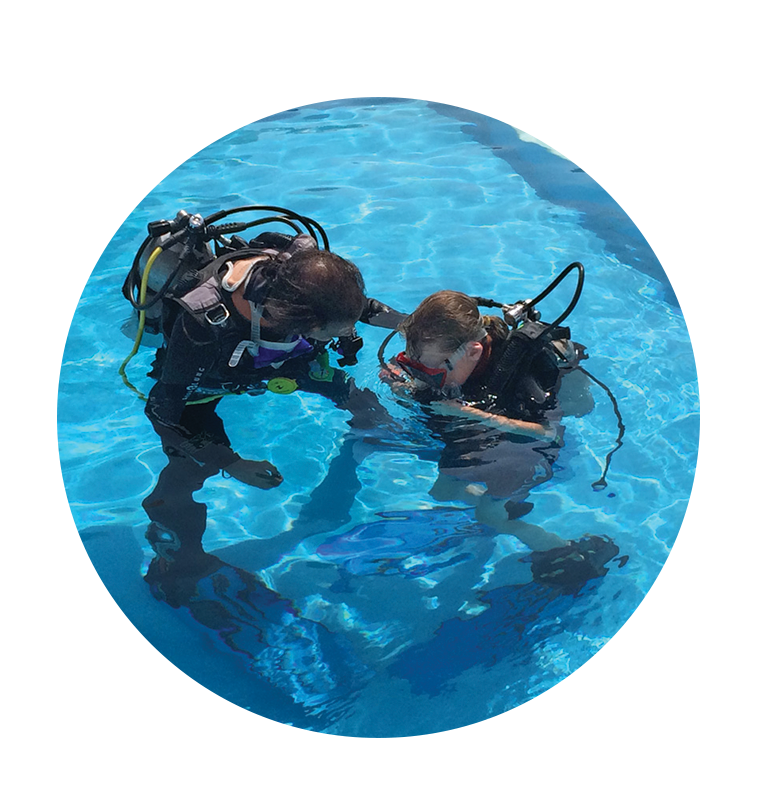
U-16 Adventurer Club
For qualified Scuba Divers regardless of age it’s the Adventurer Club and exploration of the local reefs and marine life. There will be 2 dives every day with the Open Ocean marine field station team who will introduce you to Red Sea marine life and workshops on marine research. Alternatively there are opportunities to continue your scuba diving certifications with our instructional team.
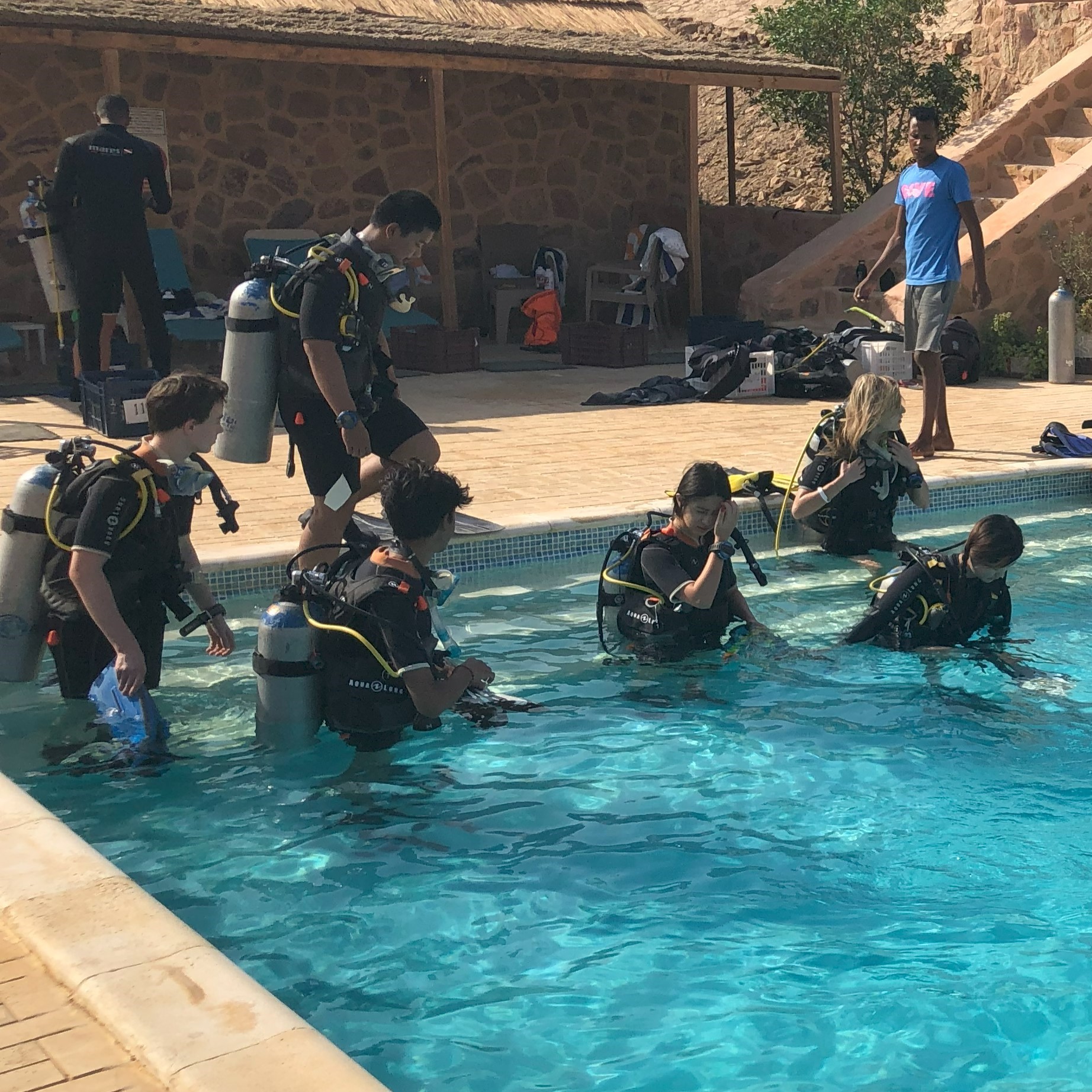
Parents are welcome to join the club activities and join the courses.
BOOK NOW: INFO@PHARAOHDIVECLUB.COM / TEL: +44 7598 329059 or +20 100 6822000
Big Blue might seem like the new kid on the block, but the team behind the highly acclaimed liveaboard is far from that. They have been running Red Sea safaris since the late 1980’s and were in fact part of the early pioneers who ventured out to the unknown on vessels that in today’s world, really shouldn’t have left the harbour! It’s that experience and the years of operating the award-winning Roots Red Sea resort which truly set Big Blue apart from the crowd!
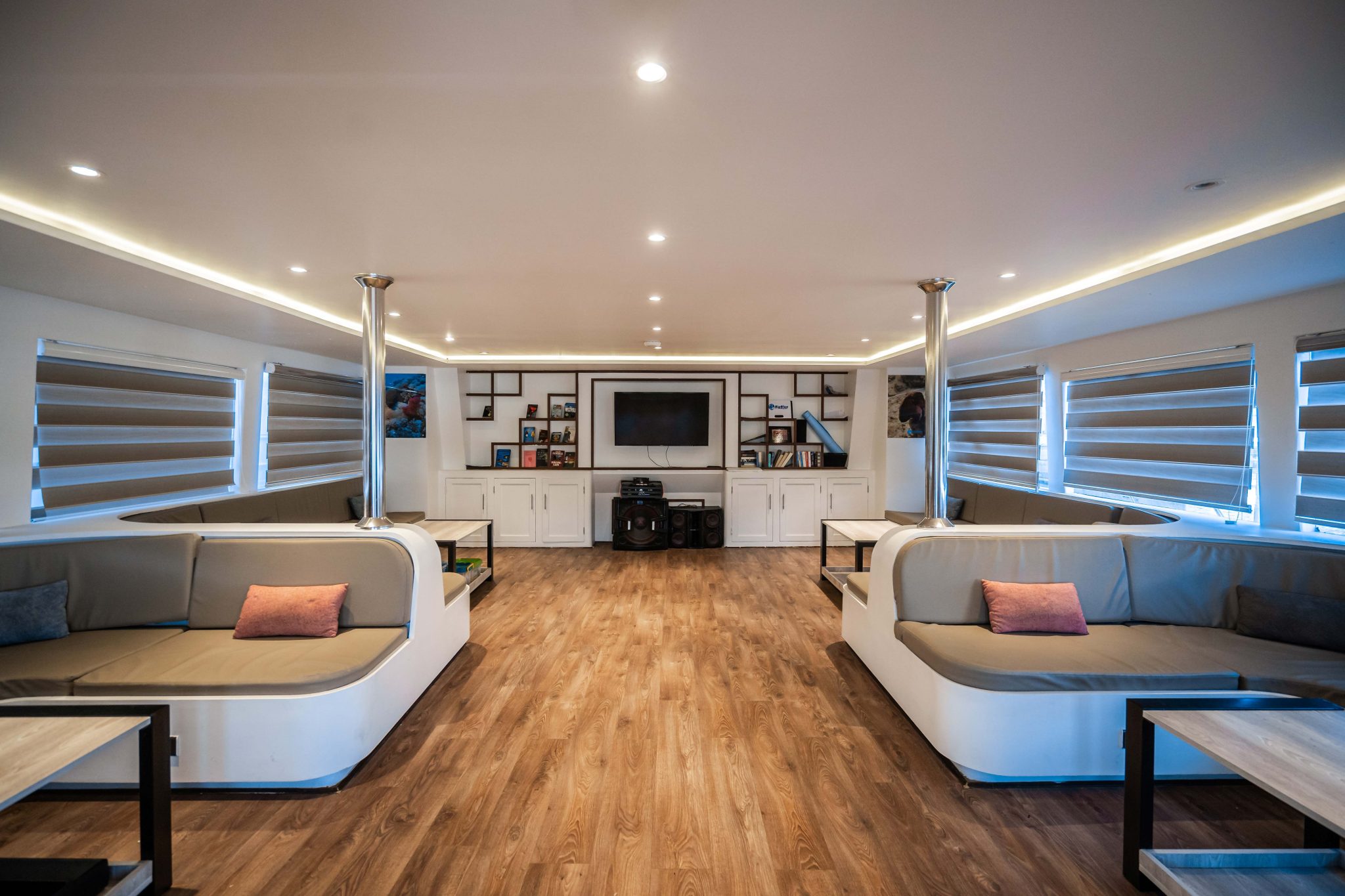
Large lounge area, spacious sun deck and terrace deck.
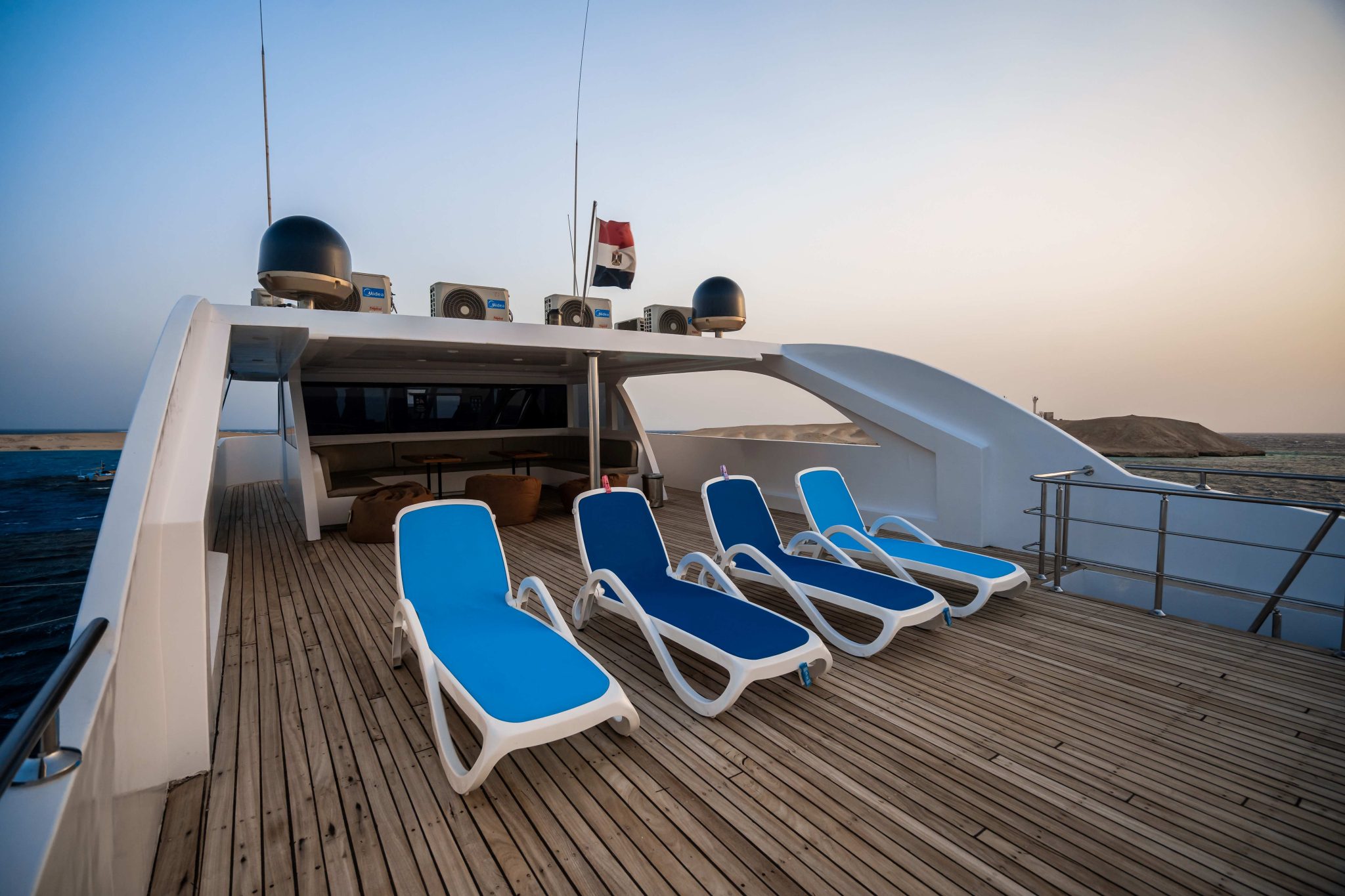
Airy restaurant with five tables with up to six chairs per table, serving a varied and delicious menu with special dietary requirements catered for.
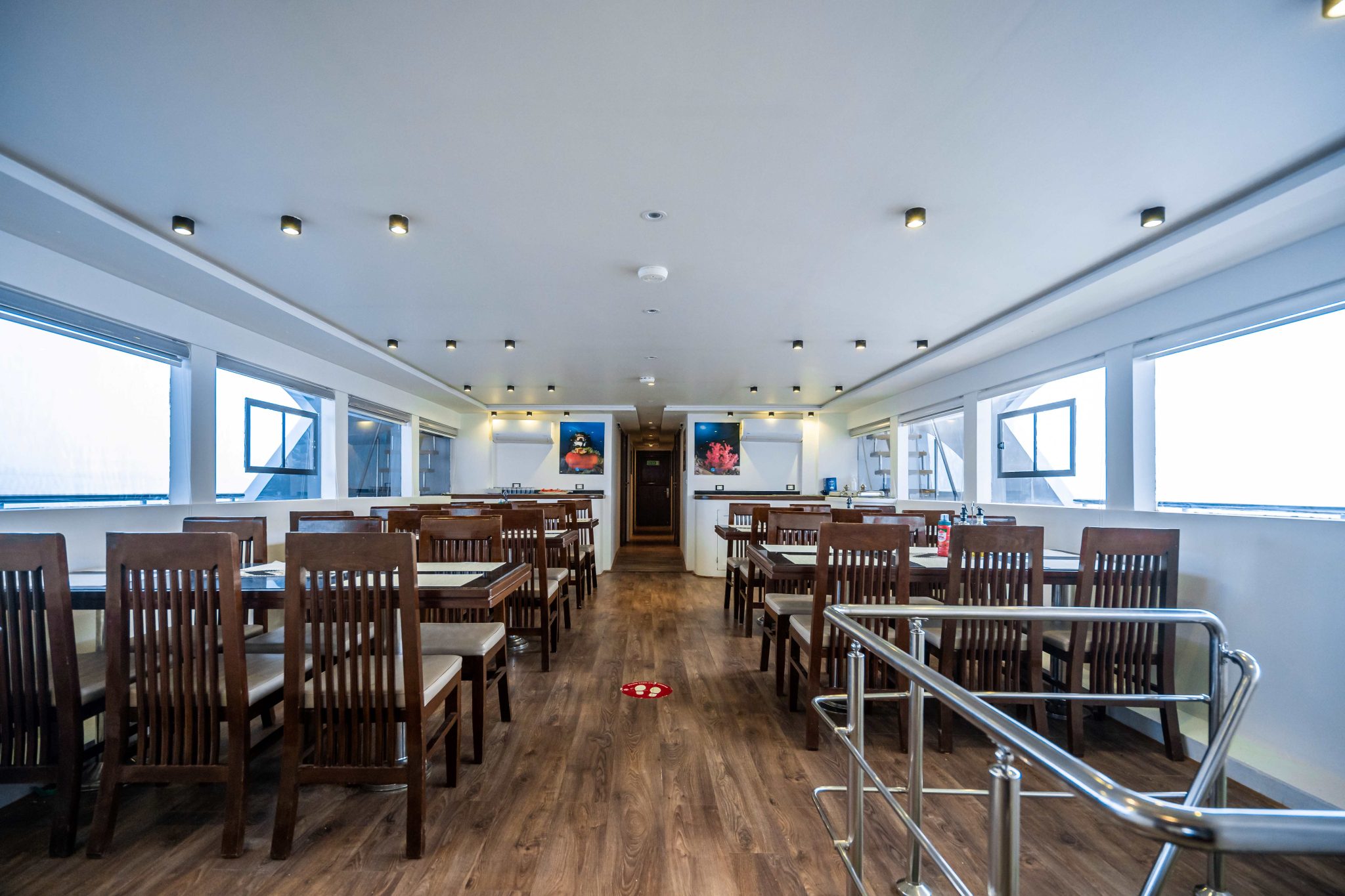
The spacious cabins have side by side beds and a large walk in wet bathroom.
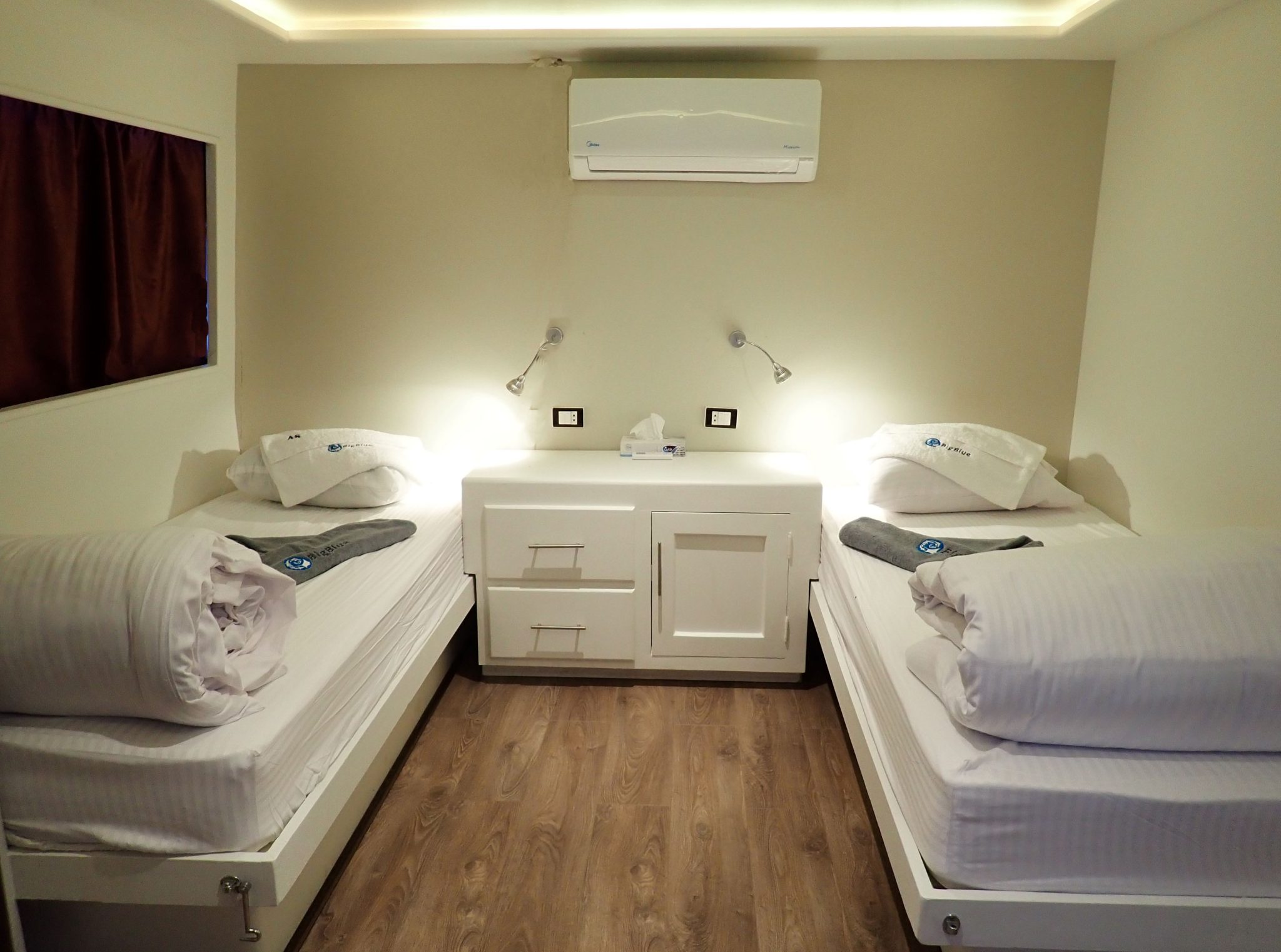
Ample dive deck for divers & snorkelers.
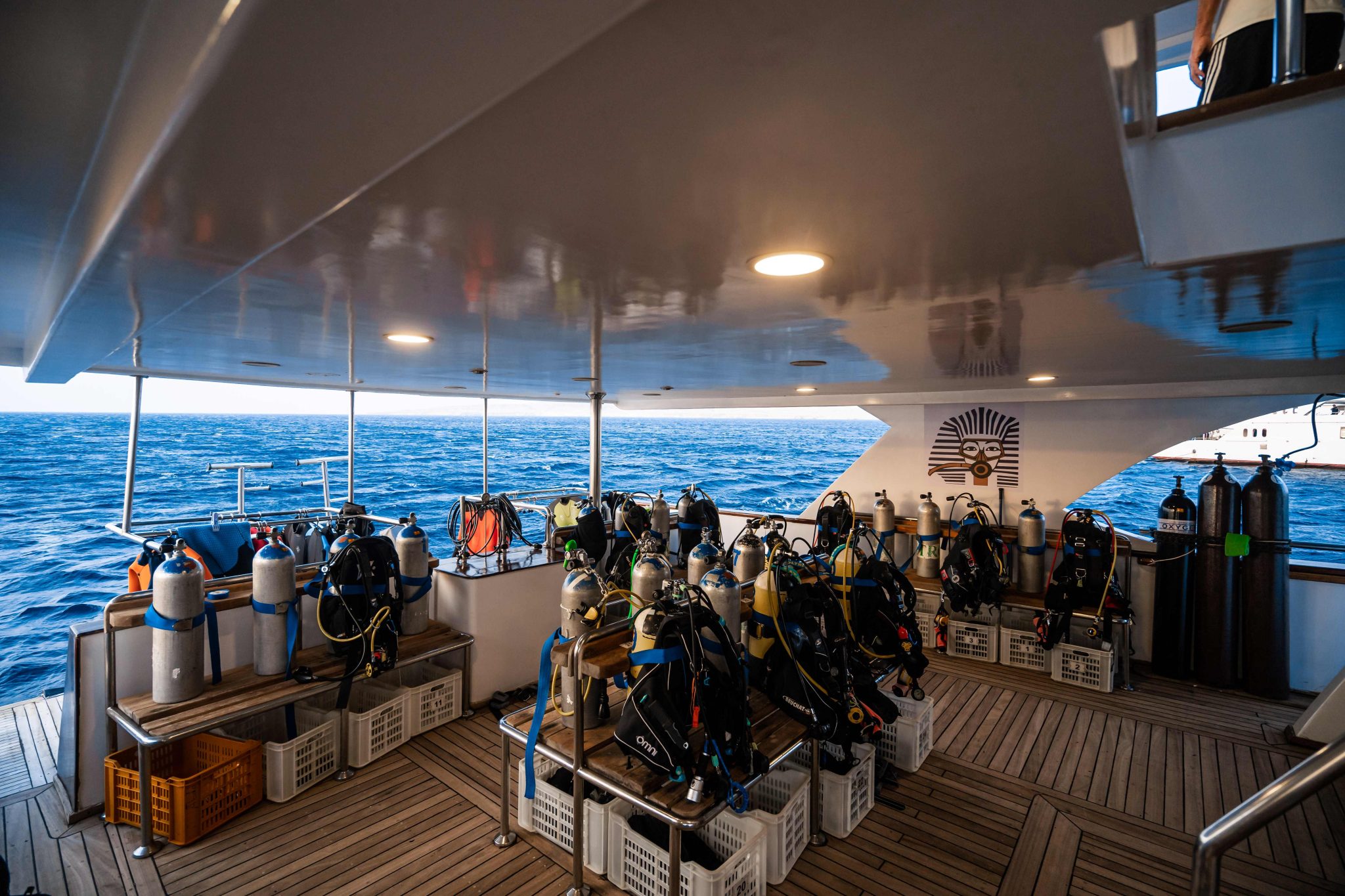
Safety is everyone’s priority, whether you are relaxing on board, swimming, snorkelling or diving.
On board Big Blue is fitted with smoke alarms, emergency lighting and a fire alarm system. The lower corridor has a full-size door fire exit at the bow and open stairs to the stern. There are evacuation plans in each room along with life jackets, glass breaker tool and a fire extinguisher.
BOOK NOW: INFO@PHARAOHDIVECLUB.COM / TEL: +44 7598 329059 or +20 100 6822000
Red Sea Splash at Fury Shoals is a very rare opportunity to get involved with marine biology expedition for children and adults. Open Ocean biologists are on board to provide fascinating and entertaining facts about the marine life you will see. The team will provide workshops on marine life identification and survey methods both of which, should you wish, you will have the chance to put into practice during your safari.
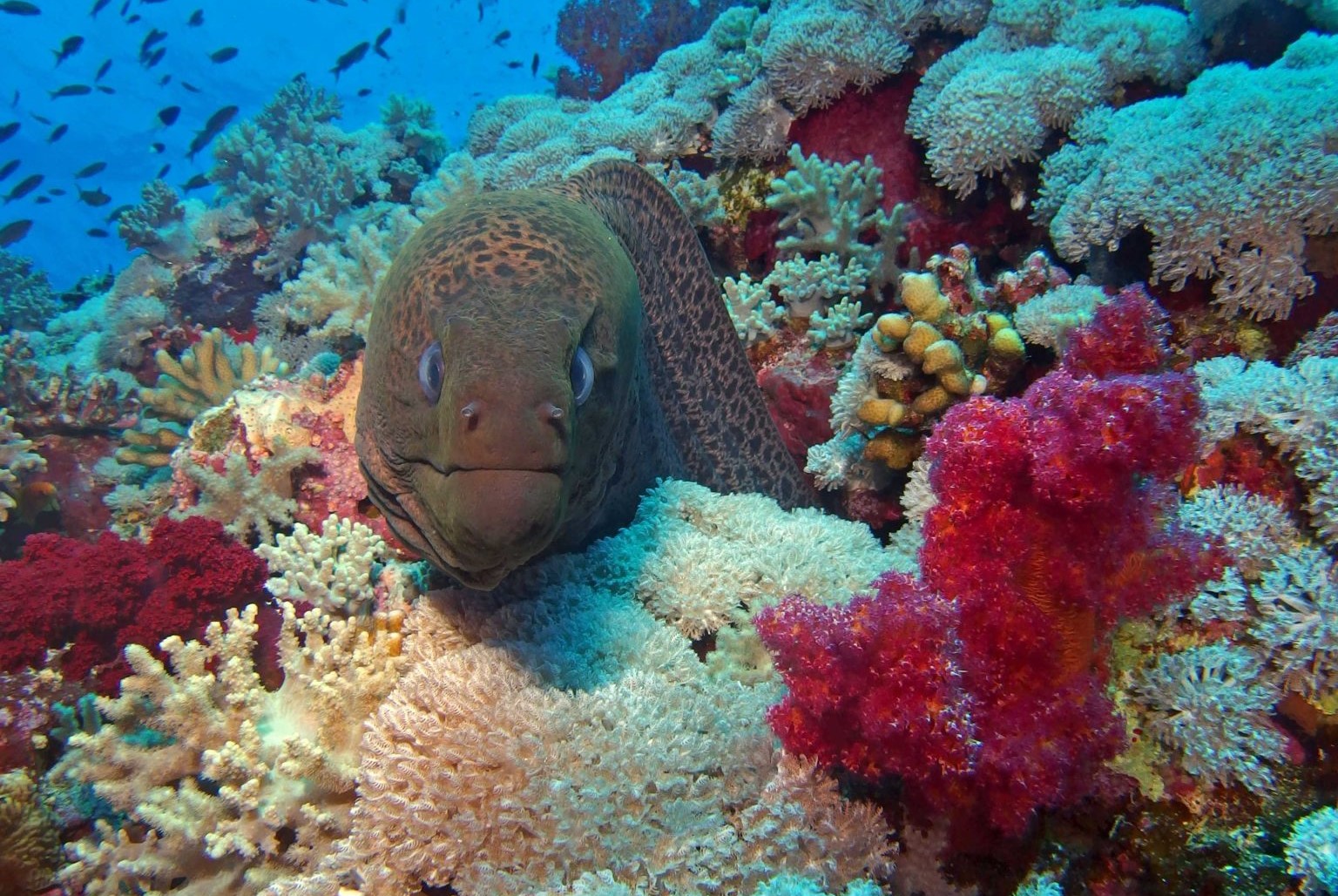
The week is open to snorkelers, scuba divers and non divers too!
Fury shoals is perfect for first time mariners as it offers plenty of protection from the weather.
We board at Port Ghaleb on Saturday evening and prepare to set sail early on Sunday morning.
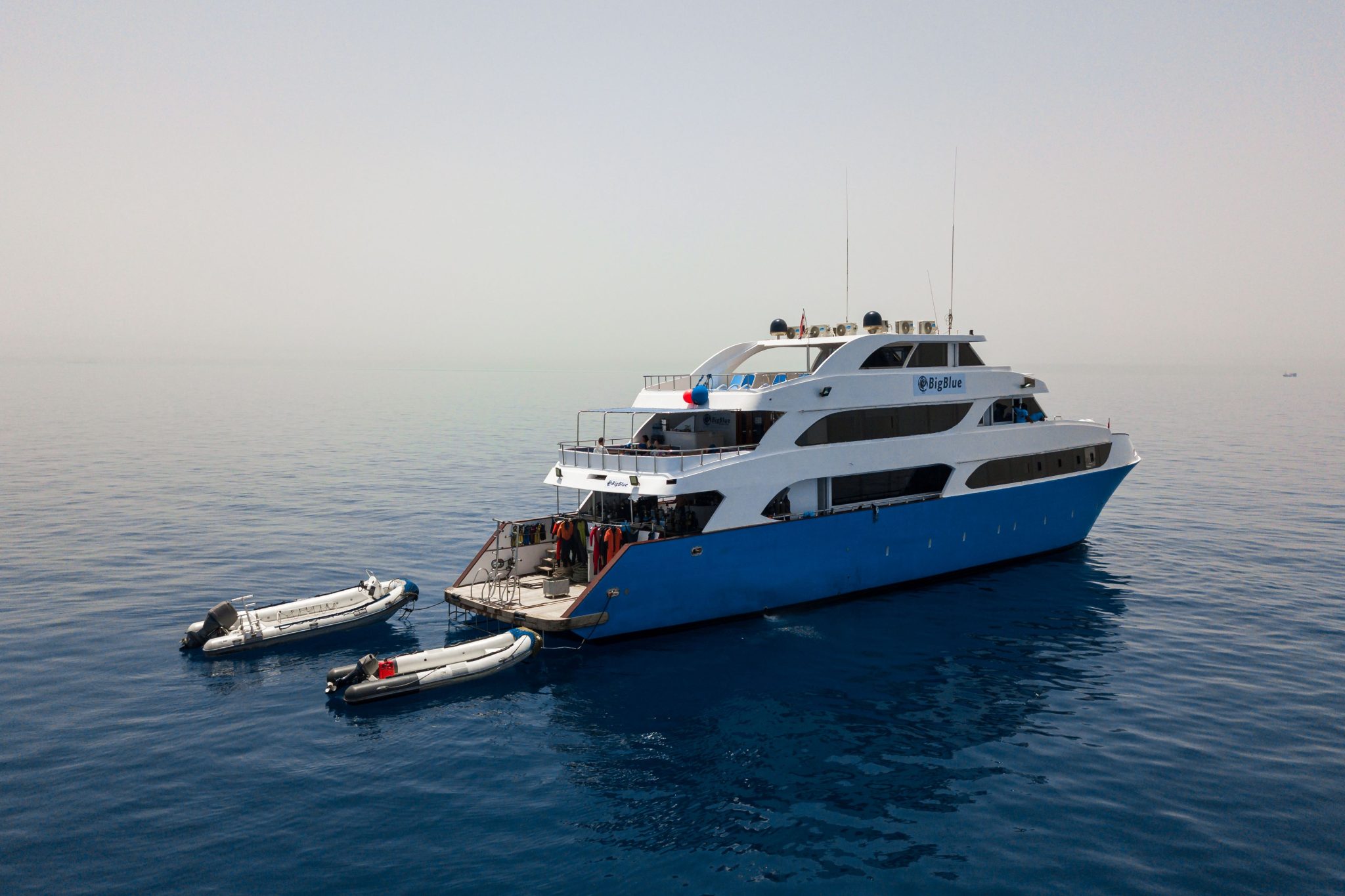
Heading south, our first day will be diving the reefs of Abu Dabbab before sailing overnight to reach our ultimate destination the Fury Shoals.
Here we will spend four days swimming, snorkelling and scuba diving amazing reefs. This includes guaranteed DOLPHIN encounters at Sataya Reef! After the last dive we haul anchor and head back to Abu Dabbab for our final two dives before disembarking our boat BIG BLUE.
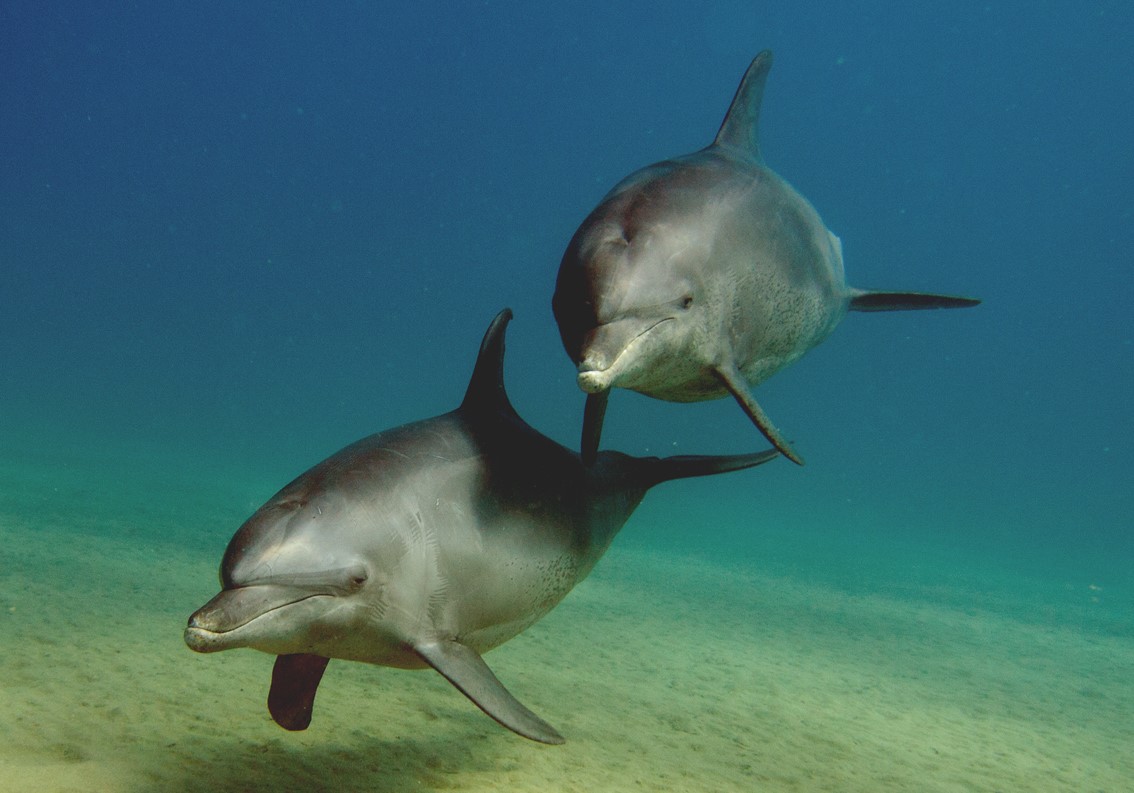
Camp Extension Cost*
Adult £650 per adult
Under 16 £350 per child
BOOK NOW: INFO@PHARAOHDIVECLUB.COM / TEL: +44 7598 329059 or +20 100 6822000
FURTHER INFORMATION – INFO@PHARAOHDIVECLUB.COM
TEL: +44 7598 329059 or +20 100 6822000
-

 News3 months ago
News3 months agoHone your underwater photography skills with Alphamarine Photography at Red Sea Diving Safari in March
-

 News2 months ago
News2 months agoCapturing Critters in Lembeh Underwater Photography Workshop 2024: Event Roundup
-

 Marine Life & Conservation Blogs2 months ago
Marine Life & Conservation Blogs2 months agoCreature Feature: Swell Sharks
-

 Blogs2 months ago
Blogs2 months agoMurex Resorts: Passport to Paradise!
-

 Blogs2 months ago
Blogs2 months agoDiver Discovering Whale Skeletons Beneath Ice Judged World’s Best Underwater Photograph
-

 Gear News3 months ago
Gear News3 months agoBare X-Mission Drysuit: Ideal for Both Technical and Recreational Divers
-

 Gear Reviews2 months ago
Gear Reviews2 months agoGear Review: Oceanic+ Dive Housing for iPhone
-

 Marine Life & Conservation2 months ago
Marine Life & Conservation2 months agoSave the Manatee Club launches brand new webcams at Silver Springs State Park, Florida


